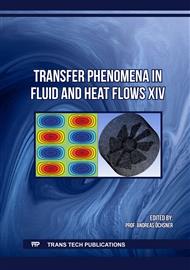p.135
p.145
p.157
p.167
p.179
p.193
p.205
p.215
p.227
Simulation of a Prototype of Individual Portable Air Purifier
Abstract:
Covid-19 is a highly contagious aero-transmissible virus. Even after two years of its emergence, new strains appear that require strengthening security measures such as social distancing, the use of masks, etc. It is crucial to prevent contamination, and care for the sanity of the air in closed environments, occupied by two or more people. Aerosols expelled by contaminated individuals dissolve in environments and can contaminate individuals regardless of their location. In this project, an air purifier for individual use was proposed to mitigate the risk of contamination by Covid-19 in closed environments. The equipment has been developed and prototyped, but has yet to be presented in the scope of this article. In this phase of the project, a study was conducted through numerical simulation to understand the effect of using this purifier on air circulation and its scope in the environment. Nine scenarios were developed: five two-dimensional and four three-dimensional, subject to different conditions: (i) closed environment, (ii) air infiltration through doors and windows, (iii) air-conditioner use, and purifier use. In individual use of the purifier, even if it is approximately 50 cm from the person in the room, the curtain of “clean air” coming from the purifier has become ineffective due to the existence of another, more intense outlet. The scenario with the airflow from the air-conditioner showed that the higher intensity of the airflow compared to the prototype purifier's airflow, meant that the prototype's airflow could not protect the user from the theoretically contaminated air mixed in the room. When the simulation of the use of the purifier was not done together with the air-conditioner runoff, the purifier proved effective in providing clean air and "protecting" the user with a wind curtain. However, even when the purified air cannot directly protect the user, the effects of the purifier can be beneficial by reducing the contamination of the air in the room as a whole (with a flow rate of 0.016 m3/s or 57.6 m3/h), and potentially reducing the chances of virus infection.
Info:
Periodical:
Pages:
179-192
Citation:
Online since:
July 2023
Keywords:
Price:
Сopyright:
© 2023 Trans Tech Publications Ltd. All Rights Reserved
Share:
Citation:


